Top Rankings
Norfolk School District ranks among the top 20% of public school district in Massachusetts for:
Category
Attribute
Overall Rank
Highest overall rank (Top 20%)
Math Proficiency
Highest math proficiency (Top 20%)
For the 2025 school year, there are 2 public elementary schools serving 1,041 students in Norfolk School District. This district's average elementary testing ranking is 9/10, which is in the top 20% of public elementary schools in Massachusetts.
Public Elementary Schools in Norfolk School District have an average math proficiency score of 65% (versus the Massachusetts public elementary school average of 40%), and reading proficiency score of 55% (versus the 42% statewide average).
Minority enrollment is 11% of the student body (majority Hispanic and Asian), which is less than the Massachusetts public elementary school average of 49% (majority Hispanic).
Overview
This School District
This State (MA)
# Schools
2 Schools
1,360 Schools
# Students
1,041 Students
605,604 Students
# Teachers
87 Teachers
51,596 Teachers
Student : Teacher Ratio
12:1
12:1
District Rank
Norfolk School District, which is ranked within the top 20% of all 393 school districts in Massachusetts (based off of combined math and reading proficiency testing data) for the 2021-2022 school year.
Overall District Rank
#75 out of 397 school districts
(Top 20%)
(Top 20%)
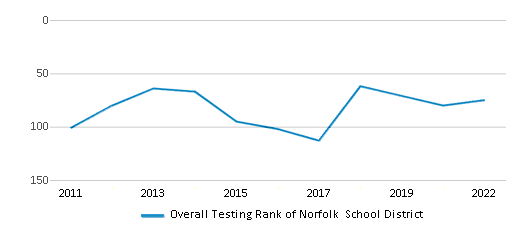
Math Test Scores (% Proficient)
63%
41%
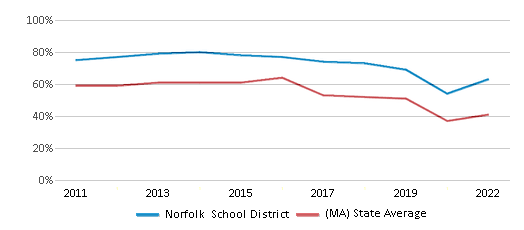
Reading/Language Arts Test Scores (% Proficient)
55%
44%
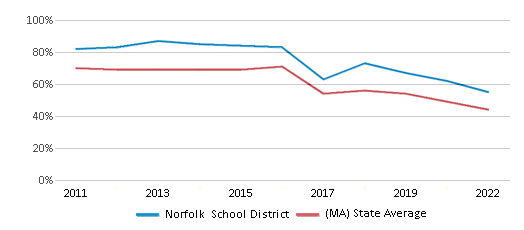
Science Test Scores (% Proficient)
60-64%
44%
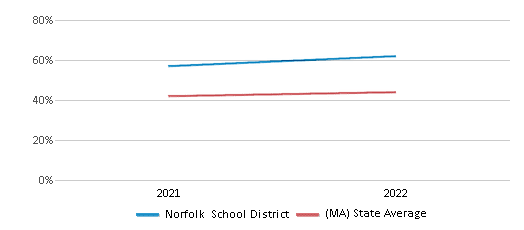
Students by Ethnicity:
Diversity Score
0.20
0.66
# American Indian Students
1 Student
1,446 Students
% American Indian Students
n/a
n/a
# Asian Students
28 Students
44,247 Students
% Asian Students
3%
8%
# Hispanic Students
30 Students
157,705 Students
% Hispanic Students
3%
26%
# Black Students
19 Students
61,567 Students
% Black Students
2%
10%
# White Students
931 Students
310,647 Students
% White Students
89%
51%
# Hawaiian Students
n/a
511 Students
% Hawaiian Students
n/a
n/a
# Two or more races Students
32 Students
29,006 Students
% of Two or more races Students
3%
5%
Students by Grade:
# Students in PK Grade:
62
20,531
# Students in K Grade:
166
58,912
# Students in 1st Grade:
117
64,458
# Students in 2nd Grade:
144
66,664
# Students in 3rd Grade:
163
64,731
# Students in 4th Grade:
126
65,978
# Students in 5th Grade:
136
67,142
# Students in 6th Grade:
127
67,086
# Students in 7th Grade:
-
56,371
# Students in 8th Grade:
-
53,443
# Students in 9th Grade:
-
5,579
# Students in 10th Grade:
-
5,198
# Students in 11th Grade:
-
4,867
# Students in 12th Grade:
-
4,504
# Ungraded Students:
-
140
District Revenue and Spending
The revenue/student of $10,598 in this school district is less than the state median of $23,845. The school district revenue/student has declined by 5% over four school years.
The school district's spending/student of $18,974 is less than the state median of $24,602. The school district spending/student has declined by 5% over four school years.
Total Revenue
$11 MM
$21,850 MM
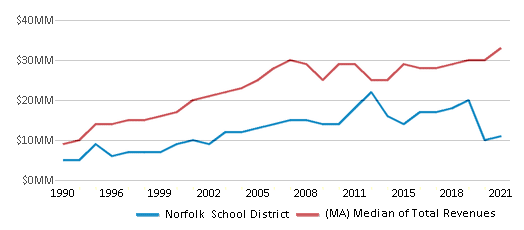
Spending
$20 MM
$22,544 MM
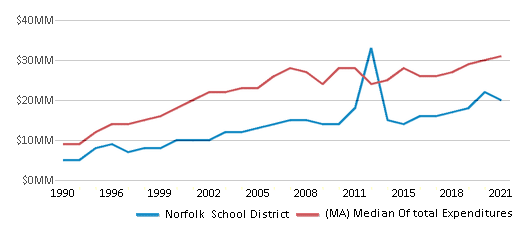
Revenue / Student
$10,598
$23,845
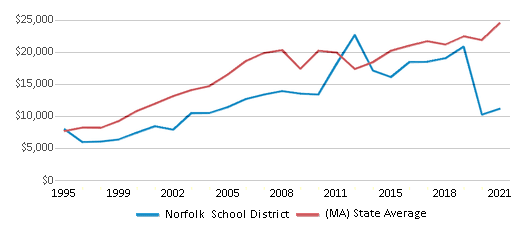
Spending / Student
$18,974
$24,602
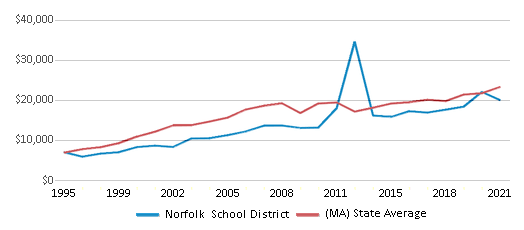
Best Norfolk School District Public Elementary Schools (2025)
School
(Math and Reading Proficiency)
(Math and Reading Proficiency)
Location
Grades
Students
Rank: #11.
Freeman-kennedy School
(Math: 65% | Reading: 55%)
Rank:
Rank:
8/
Top 30%10
70 Boardman Street
Norfolk, MA 02056
(508) 528-1266
Norfolk, MA 02056
(508) 528-1266
Grades: 3-6
| 552 students
Recent Articles

What Is A Charter School?
Explore the world of charter schools in this comprehensive guide. Learn about their history, how they operate, and the pros and cons of this educational innovation. Discover key facts about charter schools, including admission policies, demographics, and funding, as well as what to look for when considering a charter school for your child.

10 Reasons Why High School Sports Benefit Students
Discover the 10 compelling reasons why high school sports are beneficial for students. This comprehensive article explores how athletics enhance academic performance, foster personal growth, and develop crucial life skills. From improved fitness and time management to leadership development and community representation, learn why participating in high school sports can be a game-changer for students' overall success and well-being.

February 05, 2025
Understanding the U.S. Department of Education: Structure, Impact, and EvolutionWe explore how the Department of Education shapes American education, from its cabinet-level leadership to its impact on millions of students, written for general audiences seeking clarity on this vital institution.





